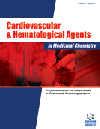- Home
- A-Z Publications
- Cardiovascular & Hematological Agents in Medicinal Chemistry (Formerly Current Medicinal Chemistry - Cardiovascular & Hematological Agents)
- Previous Issues
- Volume 16, Issue 2, 2018
Cardiovascular & Hematological Agents in Medicinal Chemistry (Formerly Current Medicinal Chemistry - Cardiovascular & Hematological Agents) - Volume 16, Issue 2, 2018
Volume 16, Issue 2, 2018
-
-
The Beneficial Therapy with Colchicine for Atherosclerosis via Anti-inflammation and Decrease in Hypertriglyceridemia
More LessBackground: Lipid-lowering therapy and control of cardiovascular risk factors are the current recommendations of atherosclerotic disease management. Despite optimal treatment the rate of acute coronary syndrome events remains high. Inflammation plays an essential role in the pathophysiology of atherosclerotic plaque formation, progression and rupture, which conclusively causes acute clinical episodes. Objecti Read More
-
-
-
Thromboxane A Synthase: A New Target for the Treatment of Cardiovascular Diseases
More LessAtherothrombosis-related diseases are one of the world’s leading causes of mortality, and thus the search for new therapeutic approaches in this area remains a very urgent task. Modern pharmacogenomic technologies make it possible to obtain valuable data on disease pathogenesis and optimal therapeutic approaches. One promising research direction is the study of the thromboxane A2 - thromboxane A synthase - thro Read More
-
-
-
Idiopathic “Cyclic” Edema: A Frustrating and Poorly Understood Clinical Problem
More LessAuthors: Thomas F. Whayne Jr and Mary B. FisherIdiopathic Edema (IE), is a syndrome involving real or perceived weight gain secondary to the pathological retention of fluid. This syndrome of generalized edema is almost solely reported in women. The diagnosis of IE is one of exclusion and requires a careful history, physical exam, and clinical suspicion. The aim of this article is to provide a comprehensive review of the available literature in order to attempt to define IE, Read More
-
-
-
Effect of Flavonoid-rich Extract of Tamarix Articulata Vahl. on Glucose and Lipid Metabolism in Normal and Diabetic Rats
More LessAuthors: Morad Hebi, Lhoussaine Hajji and Mohamed EddouksObjective: The present study was carried out in order to evaluate the antidiabetic and antihyperlipidemic potential of Flavonoid-Rich Extract of Tamarix articulata (FRETA) in both normal and Streptozotocin (STZ)-induced diabetic rats. Material and Methods: Normal and diabetic rats were treated with the FRETA for 7 days. At the end of treatment, a range of parameters was tested including blood lipid profile, histopathologi Read More
-
-
-
Perception of Patients Regarding Burdens and Benefits of Vitamin K Antagonists Among Patients with Nonvalvular Atrial Fibrillation
More LessAuthors: Carlos Escobar, Vivencio Barrios, Luis Prieto, Jose María Lobos, Jose Polo and Diego VargasBackground: Achieving a good satisfaction with anticoagulant treatment should be a target in Atrial Fibrillation (AF) patients. Objective: To ascertain the perception of patients regarding burdens and benefits of anticoagulation with Vitamin K Antagonists (VKA). Methods: This was a multicenter cross-sectional/retrospective study conducted throughout Spain, in which AF patients taking VKA during the last year, attended at prima Read More
-
-
-
Reduction in Vasa Vasorum Angiogenesis by Lp-PLA2 Selective Inhibitor Through The HIF-1α and VEGF Expression Under Dyslipidemic Conditions in Atherosclerosis Pathogenesis
More LessBackground: Atherosclerosis is a chronic inflammatory disease which may lead to major cardiovascular events. The primary cause of atherosclerosis is Dyslipidemia. The increased level of lipid profile triggers endothelial dysfunction. This results in inflammation with the recruitment of monocyte, macrophage, T lymphocyte, and Mast cells secreted by an Lp-PLA2 enzyme which causes binding between macrophage a Read More
-
-
-
Comparison and Impact of The Short-Term Use of Some Non-Aspirin NSAIDs on Bleeding Time of Mice
More LessBackground: Non-Steroidal Anti Inflammation Drugs (NSAIDs) have shown effectivity in pain relief and are the most prescribed around the world. However, NSAIDs impair hematological aspects that may lead to the life-threatening events. Objective: The objective of the study is to determine the comparison and impact of the short-term use of some non-aspirin NSAIDs on bleeding time. Method: We have 10 animals group. Ea Read More
-
Volumes & issues
-
Volume 23 (2025)
-
Volume 22 (2024)
-
Volume 21 (2023)
-
Volume 20 (2022)
-
Volume 19 (2021)
-
Volume 18 (2020)
-
Volume 2 (2020)
-
Volume 17 (2019)
-
Volume 16 (2018)
-
Volume 15 (2017)
-
Volume 14 (2016)
-
Volume 13 (2015)
-
Volume 12 (2014)
-
Volume 11 (2013)
-
Volume 10 (2012)
-
Volume 9 (2011)
-
Volume 8 (2010)
-
Volume 7 (2009)
-
Volume 6 (2008)
-
Volume 5 (2007)
-
Volume 4 (2006)
Most Read This Month
Article
content/journals/chamc
Journal
10
5
false
en


